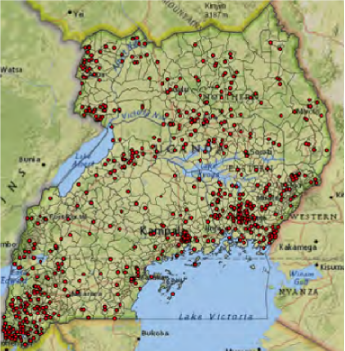By focusing primarily on economic growth, the long running debate in the international development community regarding aid effectiveness misses a social dimension for future economic growth potential. Does the positive, contemporaneous "shock" of aid in an area make people more trusting of others? Our initial findings suggest that aid has a positive effect on future growth potential by fostering social capital, which can be converted into future economic gains. Combining AidData project-level data with individual responses from Afrobarometer’s survey for Uganda, we created a unique cross-sectional database to test whether individuals living in aid-recipients counties have subsequently higher levels of trust. Specifically, we investigated the relationship between aid and perceived levels of inequality in the country, and we found that citizens who live closer to projects supported by foreign aid have higher levels of trust than those living elsewhere.
Figure 1. Geolocalized Foreign Aid in Uganda (D’Onofrio/Maggio)

The governmental structure of Uganda consists of 111 governmental districts across the country further divided into 167 counties. Figure 1 above shows the localization of aid projects in Uganda according to AidData inside of those counties. While a first glance suggests no clear pattern can be identified about their distribution, a deeper analysis reveals evidence of high concentration of projects at the border with Kenya and Rwanda (east and south-west). Furthermore, some counties in the middle of the country do not receive foreign aid at all, and we used them as a control sample in the rest of the study. However, as we found in the process of our research, there might be a reason as to why these projects are centered around certain regions, which we address later in this article.
Our Empirical Strategy
As a benchmark, we begin by estimating the relationship between the presence of aid in a county over the period 2008-2010, along with the level of trust in that county as surveyed in 2012 using a standard probit-model. Among the controls, we include the level of past trust at county level in order to measure changes in trust from the past.
Our estimates show that the presence of aid is positively correlated with the subsequent level of trust. The coefficient of the dummy for the presence of foreign aid is positive and significant throughout all the specifications considered. We then turn to the intensive margin of aid and find that an increase of one percent in the quantity of aid is associated with an increase of one percent of the probability of trusting others.
Our Instrumental Strategy: The NGO Registration Act
The positive correlation between aid in a county and the subsequent level of trust are consistent with the hypothesis that foreign aid contributed to increasing the level of trust. However, an alternative explanation for our findings is that more aid has been directed to districts that were already more trusting, and that these higher levels of trust simply remain unchanged, or there might be other factors, such as individual and county specific characteristics, that are correlated with the amount of aid flows and subsequent levels of trust. To address this issue, we used an instrumental strategy based on the enforcement of Uganda’s Non-Governmental Organizations (Amendment) Act.
Since 2006, any non-governmental organization (NGO) interested in operating and delivering aid projects to a specific county must first register and gain authorization with the corresponding district committee. As seen in Figure 2 below, the size of a governmental district varies across the country, which we feel can have an influence in whether an NGO gains authorization. By instrumenting the presence of aid in a specific county with the distance of the country from the district committee’s location, we found the link from aid to trust is causal and robust. Specifically, we found that the more distant a county is located from the seat of the district committee, the less of a likelihood that NGO’s operating in them would be approved for operations. This, in turn, has the potential to prevent foreign aid from flowing into those remote counties.As a possible explanation, we find a channel operating through lowering inequality: foreign aid has a stronger effect in counties where there is a lower level of perceived inequality.
Figure 2. Geolocalized District Committees in Uganda (D’Onofrio/Maggio)

Editor’s Note: Authors only included district committees included in their dataset
The bottom line
The main idea behind our study is that the disbursement of funds through the financing of foreign aid initiatives by donors, represents a positive contemporaneous shock that changes beliefs and social capital, and increases trust on other people. Our study supports the hypothesis that, independently from the long-debated issue between foreign aid and growth, foreign aid has an impact on trust that is commonly considered as a proxy of social capital and a determinant of future growth. Previous literature on aid was not able to capture the short-term growth effect, and in some cases, found a positive relationship between foreign aid and growth conditional on good policies. We suggest that foreign aid has a significant effect on social dimensions that could be converted into conventional economic gains in the future.
